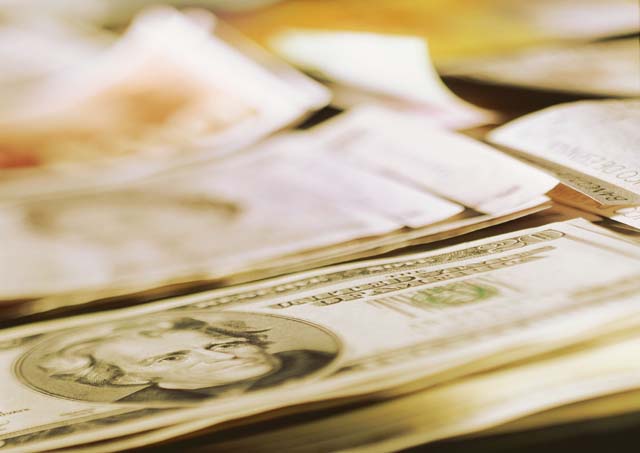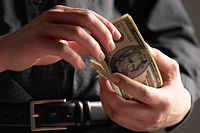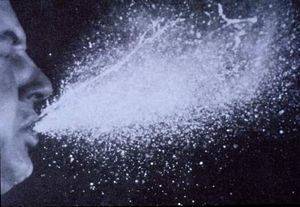Surface of Currency
Bills
Introduction
The surface of a dollar bill is surprisingly a very hospitable environment for microorganisms. A dollar bill will change hands many times before it is destroyed, and during that journey, there is a very high likelihood that the dollar will pick up bacteria from the environment.
Physical Conditions?
The surface of a dollar bill is not smooth - it is in fact very fiberous, with many pits and nooks that allow colonies to germinate and grow. The environment of a dollar bill is dependent on where the dollar is located - in a wallet, a cash register, a purse, or even the brief moments that it comes in contact with human skin.
Influence by Adjacent Communities
If you think about it, a dollar bill is a sort of a "shuttle" - it comes into contact with many different things as it passes hands from one person to another. Even the act of moving a dollar bill from one place to another brings the bill in contact with another niche – the human skin. You can frequently find bills in wallets, bringing them in contact with other bills, allowing bacteria to transfer from one bill to another. This can bring diversity to the niche, allowing organisms to come and go. From there, depending on where the dollar is spent, we can see that the bill can be transported to other places – at a street vendor, for example, we can see the organisms moving from the bill to the hands of the vendor accepting the money, to the food that the vendor is preparing, and into the mouth and stomach of someone else buying the food from the vendor.
Conditions under which the environment changes
The physical conditions of the dollar bill change drastically depending on where the dollar is located. Although the surface of a dollar bill is hospitable to organisms, the physical conditions of the dollar may not be so forgiving.
Within a wallet, which is where a dollar spends most of its time, the organisms on the dollar bill will be treated with a comfortable warm, moist, and constant environment. This will help the organisms grow and flourish. There will be little to no light, however, so there will be challenges – food will most likely be scarce for the organisms, so many will most likely enter a endospore phase to prolong their survival. This is not an ideal state for the organisms, as they are placed in a “hibernation mode” and waiting for the first opportunity to change niches – perhaps the human skin, as someone reaches into their wallet to pay.
Who lives there?
Which microbes are present?
You may refer to organisms by genus or by genus and species, depending upon how detailed the your information might be. If there is already a microbewiki page describing that organism, make a link to it.
Do the microbes that are present interact with each other?
Describe any negative (competition) or positive (symbiosis) behavior
Do the microbes change their environment?
Do they alter pH, attach to surface, secrete anything, etc. etc.
Do the microbes carry out any metabolism that affects their environment?
Do they ferment sugars to produce acid, break down large molecules, fix nitrogen, etc. etc.
Current Research
In 2001, research physicians Theodore W. Pope and Peter T. Ender of the Medical Center of Wright-Patterson Air Force Base in Ohio performed an experiment on dollar bills to discover the extent of which organisms live on dollar bills. They collected 68 bills from people standing in line at a high school sporting event and at a grocery store. They then incubated the bills in a nutrient rich broth and collected any colonies that formed. They found that more than half of the bills harbored bacteria that infected people in hospitals and were dangerous to those with weak immune systems, including Klebsiella pneumonia and Staphylococcus aureus.
References
1. J.N. "Dirty money harbors bacterial dangers" "Science News" June 2, 2001. retrieved August 25, 2008.
2. "Potential for parasite and bacteria transmission by paper currency in Nigeria.(INTERNATIONAL PERSPECTIVES)" "Journal of Environmental Health" May 1, 2007.
3. Vanzi, Sol Jose "DIRTY MONEY: YOU'RE CARRYING MORE THAN CASH IN YOUR WALLET" Philippine Headline News Online, August 20, 2003. retrieved August 24, 2008.
4. "Research Shows That Money May Not Harbour Many Pathogenic Bacteria" "General Health News" "MedIndia.net", July 13, 2006 retrieved August 24, 2008.
5. Evangeli, Anna "Myth of Dirty Money Exposed" "ABC Science Online" July 12, 2006. retrieved August 25, 2008.
6. "Research Shows That Money May Not Harbour Many Pathogenic Bacteria" "Bio-Medicine" retrieved August 24, 2008.
7. Proceedings of the National Academy of Sciences : New York University : School of Medicine : February 2007 - "Human Skin Has Many More Types Of Bacteria Than Previously Thought" Feb 26, 2007.
8. Lalonde, Michelle "Germs fester on paper money" "The Gazette" January 25, 2007. retrieved August 25, 2008.
Edited by [Brian Sun, Christopher Tom], students of Rachel Larsen



